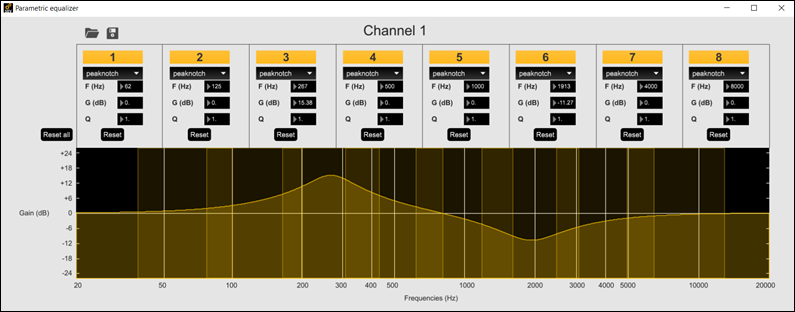This procedure shows how to compensate for the frequency responses of the speakers or
that of the whole car cabin. Conversely, this procedure can also be used as a way to
simulate the vehicle's speaker frequency responses for an "in-lab" use of the
software.
Prerequisites: The Multichannel audio output mode must be
selected.
-
Select the Settings tab.
-
Click the Speaker setup button to open the
Audio output configuration window.
-
If the audio output is turned on (
 ), click the speaker button to turn it off.
), click the speaker button to turn it off.
-
Make sure the Multichannel audio output mode is
selected.
-
In the EQ column:
- activate the Linked mode if you want to use the
equalizer over all the channels at once,
- activate the Unlinked mode if you want to use
a specific equalizer for each channel.
-
Click
 to open the Parametric equalizer for each
channel, and edit the frequency response as required using the controls
below.
to open the Parametric equalizer for each
channel, and edit the frequency response as required using the controls
below.
By default, the Parametric equalizer is configured
with 8 peaknotch filters centered on the octave bands, giving a flat
frequency response over the entire spectrum.
Each filter can be edited either by using the text boxes and drop-down menus,
or by clicking and dragging in the graphical display (see below).

The following parameters are available for each filter:
- Filter type - allows you select the filter type from the following
options:
- F(Hz) - sets the center or cutoff frequency
(depending on the selected filter type)
- G(dB) - sets the filter gain
- Q - sets the Q factor of the filter
- Reset - resets that filter to a peaknotch
filer with zero dB gain, centered at the original frequency
You can save the filter definitions by clicking the  button or load a
previously-saved configuration by clicking the
button or load a
previously-saved configuration by clicking the  button.
button.
The frequency response for multichannel audio output is now configured.




 button or load a
previously-saved configuration by clicking the
button or load a
previously-saved configuration by clicking the  button.
button.